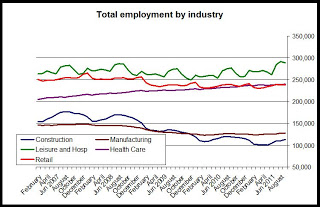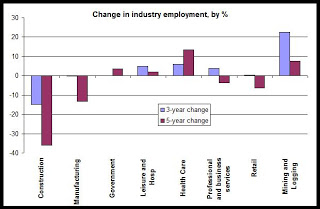Employment growth by industry is important because it can give us some idea of whether or not job growth is occurring in traditionally high-wage industries or low-wage industries.
In the first graph, one of the first things we notice is that jobs in the construction industry are down considerable over both the last three years and the last five years. Over the past five years, construction jobs in Colorado have declined by almost 36 percent, and they've dropped by more than 15 percent over the past three years. This change reflects a drop of about 41,000 jobs since 2007.

Mining and logging, on the other hand has shown a significant increase, but this industry is much smaller, and the 22 percent increase in jobs since 2009 reflects an increase of only 5,000 jobs. The construction industry now employs about 113,000 workers while mining and logging employs about 28,000 workers.
Two of the largest industries in the state, and two industries in which growth has been positive in recent years, are health care, and leisure and hospitality. Growth has been positive in both industries in both 3-year and 5-year time spans. Leisure and hospitality has added about 25,000 jobs since 2007 while health care has added about 35,000 jobs during the same period.
The second graph shows general trends in total employment in five industries since Janaury 2007. Construction and manufacturing are down while health care and leisure and hospitality are up. Retail trade has been largely flat.

The fact that so much growth has occurred in leisure and hospitality suggests that there is a growing need for housing for workers who earn wages on the low end. Health care jobs, on the other hand tend to be more mixed, although this industry can also include a large number of low wage workers such as orderlies.
The loss of so many jobs in construction, which has traditionally been an industry that provides relatively high wages to workers with limited educational levels, will likely have an overall negative impact on aggregate wages.